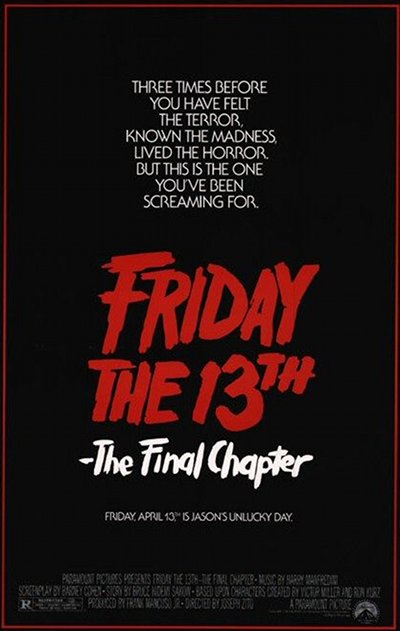
After three successful, if somewhat critically mauled, feature films, Paramount finally decided to lay their lucrative Friday the 13th franchise to rest with what promised to be The Final Chapter. Continue reading

After three successful, if somewhat critically mauled, feature films, Paramount finally decided to lay their lucrative Friday the 13th franchise to rest with what promised to be The Final Chapter. Continue reading

By the mid-nineties, the slasher film seemed like a bad dream. ‘Horror’ had become a dirty word and filmmakers were instead producing what had become known as ‘psychological thrillers.’ Continue reading
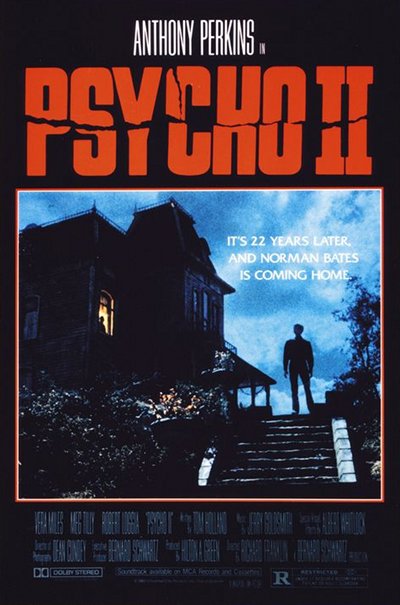
Throughout his half a century career, Alfred Hitchcock had always resisted directing a sequel. Continue reading
To hell with the ones sites have been posting from the Comic-Con event, here’s the real thing. Finally we’re starting to see some progress with the publicity for A Nightmare on Elm Street, due out next April and making a presence at this year’s high profile event. Continue reading
I will remain sceptical until its release next April, but the first image of the all-new Freddy Krueger has just made its way onto the net. Continue reading

WARNING: ADULTS ONLY
Since interviewing Jonathan and Shawn Lewis back in late 2007, I’ve been waiting in anticipation for their outrageously sleazy exploitation flick Black Devil Doll. Continue reading
I never thought I’d live long enough to see a remake of Aenigma – Lucio Fulci’s blending of Carrie and Patrick, which featured killer snails and death by Tom Cruise poster. But that’s essentially what the recent British horror Red Mist (known as Freakdog in the US) is… albeit one that’s short on molluscs and big on Jason Goes to Hell-style body-hopping.
The premise is simple: What would happen if you inadvertently sent a mentally retarded hospital janitor into a coma when a hastily organized prank designed as retaliation for a blackmail plot went wrong, only to discover that secretly injecting him with an untested wonder-drug gave him the ability not only to astral-project into the bodies of your friends, but also to stalk and kill your friends in a variety of gruesome ways while seeking misguided revenge for a crime you weren’t entirely responsible for in the first place?
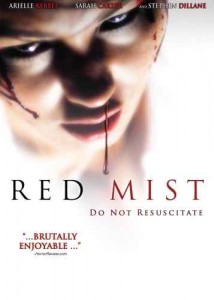 Yes, we’ve all been there, and in Red Mist it’s the turn of junior doctor, Catherine, played by highly likeable Katherine Heigl-a-like, Arielle Kebbel, who’s since gone on to star in the uninvited remake of A Tale of Two Sisters (itself called The Uninvited, aptly enough). Since it’s not until the halfway point that Catherine actually gets handy with the hypodermic, it’s a bit of a wait before the horror kicks into high gear but, with car-door head-slamming, forced acid-drinking and naked stomach-slicing in the middle of a busy nightclub, it’s certainly worth it.
Yes, we’ve all been there, and in Red Mist it’s the turn of junior doctor, Catherine, played by highly likeable Katherine Heigl-a-like, Arielle Kebbel, who’s since gone on to star in the uninvited remake of A Tale of Two Sisters (itself called The Uninvited, aptly enough). Since it’s not until the halfway point that Catherine actually gets handy with the hypodermic, it’s a bit of a wait before the horror kicks into high gear but, with car-door head-slamming, forced acid-drinking and naked stomach-slicing in the middle of a busy nightclub, it’s certainly worth it.
What’s less attractive is the last-act lull, which puts Catherine in a very reactive (as opposed to proactive) position and, in these post-Sidney Prescott days, means she doesn’t quite cut it as a top final girl. That’s not to say the movie peters out, though; in fact, it all ends quite satisfyingly – especially in comparison to director Paddy Breathnach’s previous horror effort, the hallucination-themed Shrooms, which didn’t so much peter out as flatline during an epileptic fit of meaningless, are-they-tripping-or-not jump scenes.
Breathnach is Irish, and you’ll remember I described Red Mist above as a British film, which it is despite being set in America. With a couple of exceptions, it appears the cast is a mixture of English, Irish and Scottish actors, all valiantly attempting American accents with differing degrees of success. The movie, too, is a tag-team of styles and subgenres, mixing the morbid medical school hijinks of Pathology and Unrest with torture scenes, guilty drama, and supernatural slashing. It’s as the latter it delivers most wholeheartedly, however… That, and as a gory Aenigma variation.
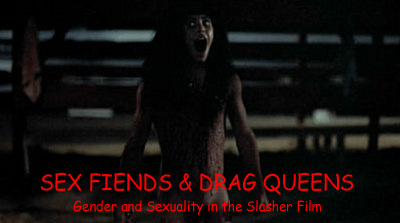
Much has been made on the treatment of females and the representation of sexuality within the horror genre. Critics have constantly overanalysed a genre whose primary function is to entertain, often stating that the slasher film represents male’s fear of feminism and that the gruesome acts of violence that these type of films focus on are the killer’s sexual frustrations being unleashed. While there may be truth with regards to specific films that have bordered on misogynistic, for the most part the slasher subgenre is a shallow and simplistic formula which often uses sexual imagery to titillate its teenage audience before providing them with the ‘money shot’ – elaborate murder set pieces. That is not to say that various filmmakers have brought a certain degree of intelligence or subtext to their work, but more often than not these movies are purely to cater for fans of elaborate special effects and soft nudity. They are, after all, the genre’s target audience.
Horror has always come under fire with regards to the violence that is levelled at females yet the treatment of their male counterparts never seems to be an issue. After all, some of the most notorious scenes in slasher history (the ‘arrow in the throat’ death from Friday the 13th, blood being spewed from the bed in A Nightmare on Elm Street or the severed fingers from The Burning) were focused on violence against males. They often prove inadequate and unhelpful, as do most authority figures, leaving the ‘final girl’ to fend for herself, eventually finding the strength and the courage to conquer and destroy the male monster. The female victims may often be killed either during or shortly after having sex, but so are the males, and the latter are usually being misguided by their ‘little head,’ meaning that they are easier prey. The choice of camera angles is another analysed device, with critics often accusing the ‘killer’s point-of-view’ device as a way for the male audience to lust over those female characters on screen, who are usually the kind of girls that would be out of their league in the real world, but this was an effective tool famously used by Alfred Hitchcock in Psycho (the proto-slasher) and is more often than not an effective way to increase tension shortly before the killer takes his next victim.
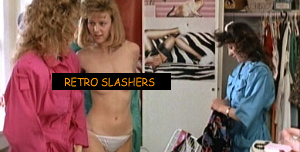 The slasher film is commonly referred to as a ‘male dominated genre,’ in that these films are usually written and directed by men and thus aimed at a similar audience. But this argument is redundant, as those slashers that were made by women, such as Sorority House Massacre and The Slumber Party Massacre (the latter of which was penned by feminist writer Rita Mae Brown), often feature more graphic nudity and voyeuristic camera angles than male-directed slashers like Halloween or even Friday the 13th. And simply insisting that these female slashers were made in such a way as to cater for their male audiences would be a futile debate, as that would make these filmmakers no more respectable than any of the countless male directors who have employed similar methods to entertain their audiences. One of the most notorious ‘splatter’ movies was Tobe Hooper’s The Texas Chainsaw Massacre which, as has been noted time and time again, features no nudity, sexual imagery and very little bloodshed.
The slasher film is commonly referred to as a ‘male dominated genre,’ in that these films are usually written and directed by men and thus aimed at a similar audience. But this argument is redundant, as those slashers that were made by women, such as Sorority House Massacre and The Slumber Party Massacre (the latter of which was penned by feminist writer Rita Mae Brown), often feature more graphic nudity and voyeuristic camera angles than male-directed slashers like Halloween or even Friday the 13th. And simply insisting that these female slashers were made in such a way as to cater for their male audiences would be a futile debate, as that would make these filmmakers no more respectable than any of the countless male directors who have employed similar methods to entertain their audiences. One of the most notorious ‘splatter’ movies was Tobe Hooper’s The Texas Chainsaw Massacre which, as has been noted time and time again, features no nudity, sexual imagery and very little bloodshed.
There is no denying that art imitates life, and vice versa. For it can be no coincidence that the first appearance of the ‘final girl’ coincided with the rise of feminism in the early seventies, with the horror genre before this often portraying women as damsels in distress that must wait for the hero to save them. This is a cliché that the action movie has continued to employ, but the horror film (from American offerings like Black Christmas and Alien to European flicks such as Suspiria) has at least attempted to exploit this change in society into its storytelling. In fact, the slasher film not only portrayed their female protagonists as resourceful and independent, but also began to include women killers, who were more than capable of overpowering males before being defeated by the heroine. A variety of slashers to employ this kind of ‘twist’ ending included Friday the 13th, Happy Birthday to Me and, perhaps most controversially, Sleepaway Camp.
 On vary rare occasions does a male survive until the end of a slasher. Even in Friday the 13th Part 6: Jason Lives (who had already lived through two previous films) and A Nightmare on Elm Street Part 2: Freddy’s Revenge, the heroes once again have to rely on a female to save them and defeat the monsters. Perhaps The Burning is the best example, where two males manage to survive, though one of them was responsible for the carnage to begin with. It is not common for a male to successfully come to the rescue of the heroine without having to sacrifice his life, and even then the female is the one to be victorious. Males are often poorly written and lack any kind of true strength or courage, they are usually just ‘machete fodder’ and display no common sense. While there may be female characters who are portrayed in a similar light, the final girl is always on hand to save the day, without any male assistance.
On vary rare occasions does a male survive until the end of a slasher. Even in Friday the 13th Part 6: Jason Lives (who had already lived through two previous films) and A Nightmare on Elm Street Part 2: Freddy’s Revenge, the heroes once again have to rely on a female to save them and defeat the monsters. Perhaps The Burning is the best example, where two males manage to survive, though one of them was responsible for the carnage to begin with. It is not common for a male to successfully come to the rescue of the heroine without having to sacrifice his life, and even then the female is the one to be victorious. Males are often poorly written and lack any kind of true strength or courage, they are usually just ‘machete fodder’ and display no common sense. While there may be female characters who are portrayed in a similar light, the final girl is always on hand to save the day, without any male assistance.
Take A Nightmare on Elm Street, for example. At various points throughout the story the protagonist, Nancy Thompson, is forced to rely on two key male characters – her boyfriend, Glen Lantz, and her father (who is also a police lieutenant). Both fail in not only protecting her but, in Glen’s case, also himself. Nancy is left to defend herself and it is her inner strength that finally defeats the monster. It is her own courage in turning her back on the maniac and taking away his hold over her that finally subdues him and allows her to survive. It is worth noting that the ridiculous epilogue was not included in Wes Craven’s screenplay and was instead added at the insistence of the film’s producer, Robert Shaye, as a means to pave the way for a later sequel.
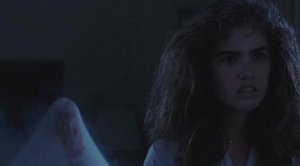 The slasher film may often feature unnecessary nudity, but realistically how often is it actually needed in a movie? It is usually included to keep the viewer’s interest until the next interesting set piece. While the likes of Maniac, Nightmare in a Damaged Brain and The New York Ripper may at times border on misogynistic, the majority of slashers use sex and violence as entertainment and occasionally the two will be used simultaneously. Perhaps it is giving these filmmakers too much credit to say that they are intentionally including some kind of anti-feminist subtext in their work, as the likes of Tony Maylam, Joe Giannone or Armand Mastroianni have hardly been renowned for their intelligent output. Some films are designed to make you think and question the world around you. In most cases, this won’t be a slasher. They are usually dumb and generic, but in some ways that is part of their charm.
The slasher film may often feature unnecessary nudity, but realistically how often is it actually needed in a movie? It is usually included to keep the viewer’s interest until the next interesting set piece. While the likes of Maniac, Nightmare in a Damaged Brain and The New York Ripper may at times border on misogynistic, the majority of slashers use sex and violence as entertainment and occasionally the two will be used simultaneously. Perhaps it is giving these filmmakers too much credit to say that they are intentionally including some kind of anti-feminist subtext in their work, as the likes of Tony Maylam, Joe Giannone or Armand Mastroianni have hardly been renowned for their intelligent output. Some films are designed to make you think and question the world around you. In most cases, this won’t be a slasher. They are usually dumb and generic, but in some ways that is part of their charm.
Whist I’m not really a fan of the series, the poster for Saw VI which just hit the net is simple-yet-effective. Continue reading

Scarecrows have had a troubled history in cinema. With perhaps the exception of The Wizard of Oz and Batman Begins, the majority of movies that they appear in tend to be shite. Continue reading